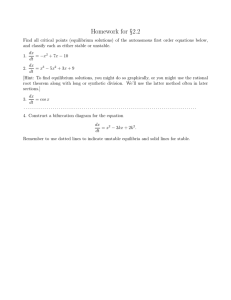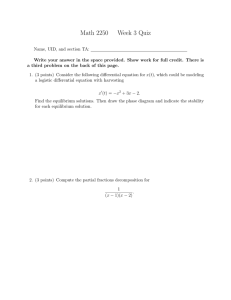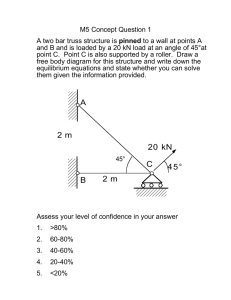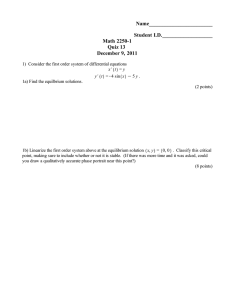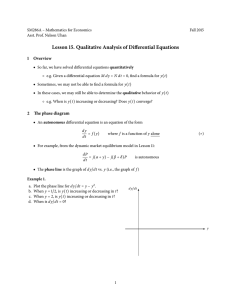2.5: Autonomous Differential Equations and Equilibrium Analysis An
advertisement
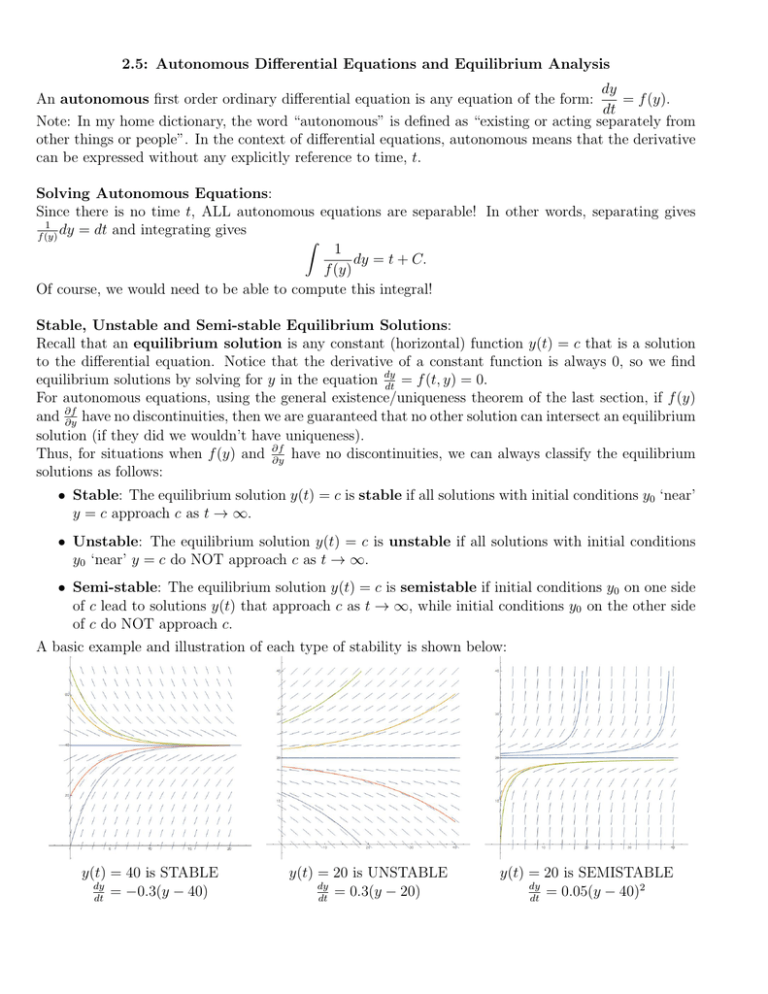
2.5: Autonomous Differential Equations and Equilibrium Analysis dy = f (y). An autonomous first order ordinary differential equation is any equation of the form: dt Note: In my home dictionary, the word “autonomous” is defined as “existing or acting separately from other things or people”. In the context of differential equations, autonomous means that the derivative can be expressed without any explicitly reference to time, t. Solving Autonomous Equations: Since there is no time t, ALL autonomous equations are separable! In other words, separating gives 1 dy = dt and integrating gives f (y) Z 1 dy = t + C. f (y) Of course, we would need to be able to compute this integral! Stable, Unstable and Semi-stable Equilibrium Solutions: Recall that an equilibrium solution is any constant (horizontal) function y(t) = c that is a solution to the differential equation. Notice that the derivative of a constant function is always 0, so we find = f (t, y) = 0. equilibrium solutions by solving for y in the equation dy dt For autonomous equations, using the general existence/uniqueness theorem of the last section, if f (y) have no discontinuities, then we are guaranteed that no other solution can intersect an equilibrium and ∂f ∂y solution (if they did we wouldn’t have uniqueness). have no discontinuities, we can always classify the equilibrium Thus, for situations when f (y) and ∂f ∂y solutions as follows: • Stable: The equilibrium solution y(t) = c is stable if all solutions with initial conditions y0 ‘near’ y = c approach c as t → ∞. • Unstable: The equilibrium solution y(t) = c is unstable if all solutions with initial conditions y0 ‘near’ y = c do NOT approach c as t → ∞. • Semi-stable: The equilibrium solution y(t) = c is semistable if initial conditions y0 on one side of c lead to solutions y(t) that approach c as t → ∞, while initial conditions y0 on the other side of c do NOT approach c. A basic example and illustration of each type of stability is shown below: y(t) = 40 is STABLE dy = −0.3(y − 40) dt y(t) = 20 is UNSTABLE dy = 0.3(y − 20) dt y(t) = 20 is SEMISTABLE dy = 0.05(y − 40)2 dt Classifying Equilibrium Solutions: dy = f (y). (and assuming f and Given dt ∂f ∂y are continuous) 1. Solve f (y) = 0 to get the equilibrium solutions. 2. Study f (y) around the equilibrium values as follows (drawing f (y) might help): (a) Draw a vertical line (the phase line) and make tick marks at equilibrium values. (b) Between tick marks determine if f (y) is positive or negative. (c) If f (y) is positive, then (d) If f (y) is negative, then dy dt dy dt will be positive so any solution in this region will be increasing. will be negative so any solution in this region will be decreasing. 3. Classify: (a) Increasing below and decreasing above =⇒ stable. (b) Decreasing below and increasing above =⇒ unstable. (c) Decreasing below and above OR increasing below and above =⇒ semistable. Examples: 1. Find and classify the equilibrium points of dy dt = (1 − y)(3 − y). (a) y(t) = 1 and y(t) = 3 are the equilibrium solutions. (b) For y > 3: dy is positive, so y(t) is increasing. dt is negative, so y(t) is decreasing. For 1 < y < 3: dy dt dy For y < 1: dt is positive, so y(t) is increasing. (c) Thus, y(t) = 1 is stable. And y(t) = 3 is unstable. 2. Find and classify the equilibrium points of dy dt = −(y − 10)2 (y − 4). (a) y(t) = 4 and y(t) = 10 are the equilibrium solutions. (b) For y > 10: dy is negative, so y(t) is decreasing. dt For 4 < y < 10: dy is negative , so y(t) is decreasing. dt dy For y < 4: dt is positive, so y(t) is increasing. (c) Thus, y(t) = 4 is stable. And y(t) = 10 is semistable. 3. Find and classify the equilibrium points of dy dt = (y 3 − 8)(ey − 1). (a) y(t) = 0, y(t) = 2 are the equilibrium solutions. (b) For y > 2: dy is positive, so y(t) is increasing. dt For 0 < y < 2: dy is negative, so y(t) is decreasing. dt dy For y < 0: dt is positive, so y(t) is increasing. (c) Thus, y(t) = 0 is stable. And y(t) = 2 is unstable. Population Dynamics: Typically, the rate of change of a population is only dependent on the current population size in some way. Thus, the differential equation for a population is typically time-independent (so it is autonomous). The study of populations is a big application of differential equations that we have been waiting to discuss until now. 1. Let y = y(t) = the size of the population at time t. This could be any organism (people, people that have disease, people that know a rumor, bugs, bacteria, fish, other animals, plants, ...). dy = rate of change of population with respect to time. dt For example, if y is in bacteria and t is in minutes, then the units of dy will be bacteria/minute. dt dy So dt can, roughly, be thought of as the number of bacteria that will be added to the population over the next minute (I say ‘roughly’ because it actually is the instantaneous rate which is not exactly the same as the average rate over the next minute, but they would be very, very close). 2. Thus, We considered three models in lecture: • Unrestricted (Natural) Growth: dy = ry dt – Plenty of food and space. Assumes: “The rate of change of the population proportional to the population size.” – r = relative growth rate (decimal version of the percentage growth per time). So ry is the approximate number of people added to the population each year. – The solution is exponential. – There is only one equilibrium at y(t) = 0 and, for positive r, it is unstable. y dy =r 1− y, with 0 < K and r > 0. • Logistic Growth: dt K – Initially like unrestricted growth, but there is a carrying capacity K that the population size can’t exceed. – For positive r, there are two equilibrium at y(t) = 0 which is unstable and y(t) = K which is stable. dy y y = −r 1 − 1− y with 0 < T < K, r > 0 • Logistic Growth with a Threshold: dt K T – If the population size is below a certain threshold size, T , then the population will decrease to zero. If the population is above this threshold, then the population behaves like logistic growth. – For positive r, there are three equilibrium at y(t) = 0 which is stable, y(t) = T which is unstable, and y(t) = K which is stable.
